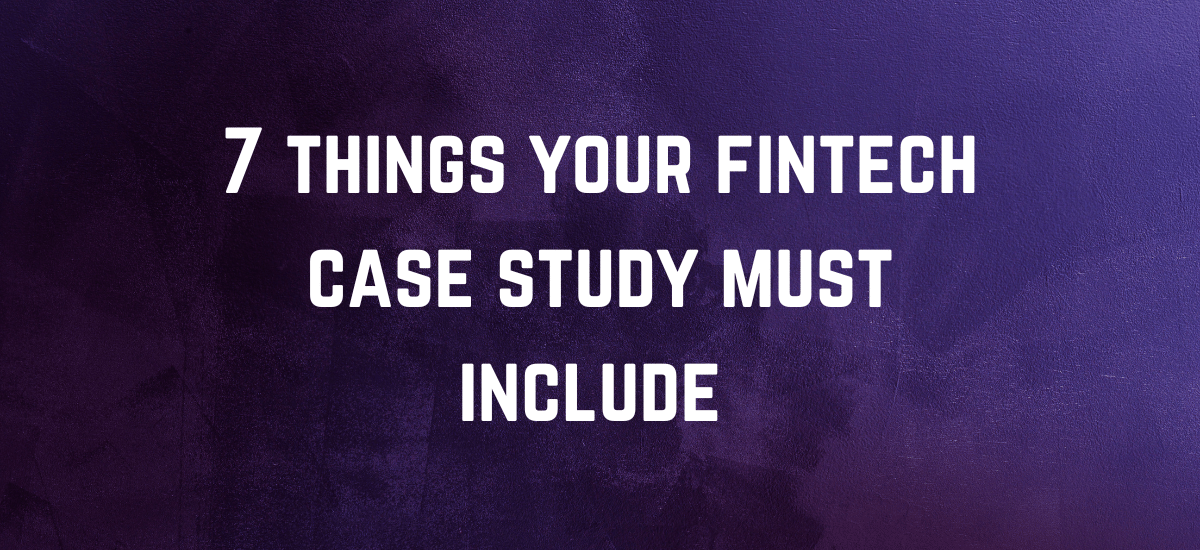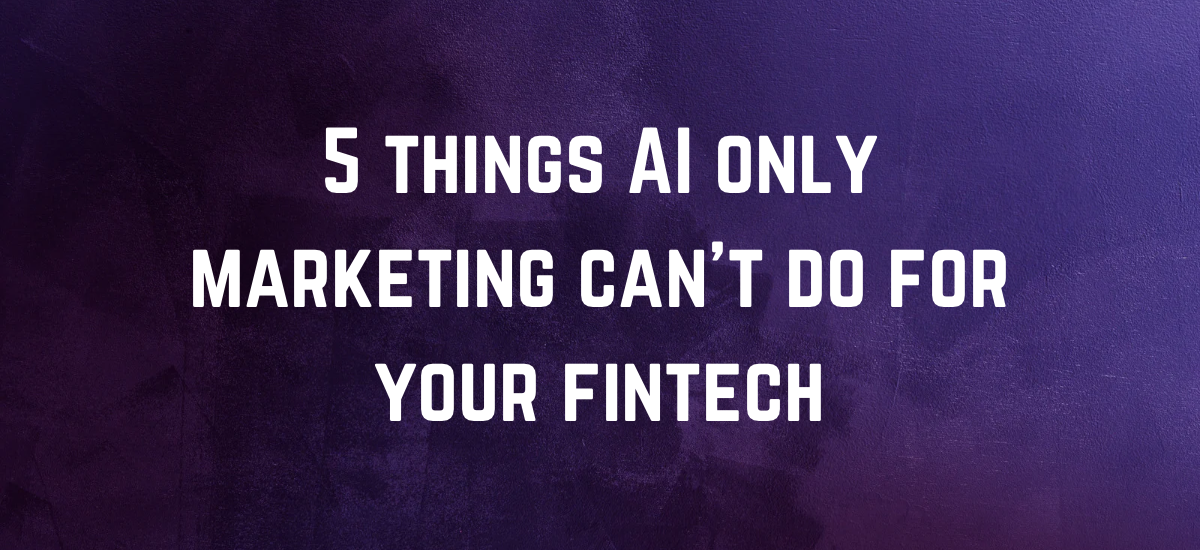by deborah
Share
by deborah
Share

It is incredibly hard to deny the advantage B2B fintechs have over their B2C counterparts.
In 2022 alone, investments in B2B fintechs in Europe reached $18.5 billion while investments in B2C fintechs capped out at $7.5 billion, according to a November 2022 report.
With this tremendous gap in investment — a gap that experts expect to continue widening — it’s no wonder why so many fintechs are seeking out new B2B business opportunities.
The increasing number of fintechs entering the B2B space has led to higher competition as well. As a result, these B2B fintechs must consider how to develop an effective marketing strategy that attracts their ideal clients and set them apart from competitors.
In this article, we discuss what B2B fintech marketing is, how it differs from B2C marketing, and five key strategies to leverage for a successful B2B fintech marketing strategy in 2023.
What is B2B Fintech Marketing?
B2B fintech marketing is a type of marketing strategy designed specifically for B2B-oriented fintechs.
A B2B (business-to-business) fintech company provides other businesses with fintech products and services to help support that business. For example, e-Commerce platforms often rely on partnerships with B2B fintechs to establish efficient and compliant digital payment systems.
Attracting B2B fintech clients is not entirely dissimilar from attracting regular everyday consumers.
The key difference between B2B and B2C (business-to-customer) marketing is the audience you aim to attract. Rather than marketing your products and services to be appealing to customers, you must instead focus on how your solutions can benefit a business client and their respective business model.
When marketing to other businesses, you need to emphasize how your fintech services can improve key aspects of the client’s business, such as:
- Boosting revenue
- Increasing customer attraction
- Improving customer retention
- Enhancing operational efficiency
- Optimizing technology usage
No matter what types of services you offer or what types of businesses you hope to attract, it is crucial to have a clear marketing strategy in place to help you achieve your goals.
5 Key Strategies for Effective B2B Fintech Marketing
When it comes to marketing strategies for B2B fintechs, there is considerable overlap with B2C marketing strategies. What sets these two types of strategies apart is the overall goals that a fintech hopes to accomplish and the types of clients it strives to attract.
This can result in some differences in how a fintech carries out a marketing strategy. For instance, a B2C fintech company may use social media to build brand loyalty, while a B2B fintech might instead use social media to connect with relevant businesses and grow its professional network.
With this in mind, let’s look at five key components of an effective B2B fintech marketing strategy:
1. Search Engine Optimization (SEO)
No matter what type of fintech business you operate, SEO is the marketing king.
Search engine optimization — or SEO for short — helps your website appear higher on search engine result pages on popular search engines like Google.
Web traffic that arrives on your website via a search engine is known as organic traffic — and for many B2B companies, organic traffic is the key to driving successful marketing efforts.
In a 2019 BrightEdge Research report, it is revealed that organic search accounts for 53.3% of web traffic across all industries. Additionally, the report states that B2B companies can generate 2X the amount of revenue from organic search traffic compared to any other marketing channel.
Achieving a strong SEO strategy comes down to a combination of optimized content and back-end processes. Successful SEO strategies are often coupled with content marketing, which leads us directly to our second key strategy for B2B fintech marketing.
2. Content Marketing with Videos
Aside from optimizing your website and ensuring all back-end technicalities are in order, the best way to boost your SEO ranking as a B2B fintech is through content marketing.
Content marketing can include a variety of different types of content, including:
- Blogs and written articles
- Video content (demos, seminars, company spotlights, etc.)
- Podcasts
- Infographics
- Long-form content (eBooks, whitepapers, market research, etc.)
As content becomes increasingly digital and mobile, the popularity of video content is on the rise as well.
According to a July 2022 HubSpot report, 81% of marketers believe that video content has a “direct, positive impact” on sales. A further 94% of marketers agree that video content helps increase user understanding of a product or service.
As a B2B fintech company, creating content that helps your business clients gain a deeper and more thorough understanding of your solutions is paramount.
Video content allows you to provide clients with a more in-depth explanation of your products and services, heightening your chances of landing business deals and sales.
3. Social Media Marketing
Social media can be an incredibly powerful marketing tool when used correctly.
Oftentimes, marketers mistake social media as a B2C-only tool. Yet, social media can offer major advantages to B2B marketers and companies that choose to take advantage of it.
According to 2020 research from Smart Insights, social media and social media advertising is used by 75% of B2B marketers in their overall marketing strategies. This research also reveals that video content can be tremendously helpful in boosting the effectiveness of social media marketing.
The biggest difference between B2C and B2B social media marketing is which platforms are used.
For B2C marketing, social media platforms like Instagram, Facebook, Twitter, and TikTok are the main focus of marketing strategies.
Comparatively, LinkedIn is the preferred social media platform for B2B marketers. Research reveals that roughly 80% of B2B social media leads are gained through LinkedIn.
4. Email Marketing
Email marketing has long been a staple in any digital B2B marketing campaign.
In October 2022, HubSpot published the HubSpot Blog’s 2023 Marketing Strategy & Trends Report which analyzed data from more than 1,200 global marketers. This report revealed that email marketing is among the top three marketing channels, with 32% of marketers leveraging email marketing.
Additionally, 2020 Content Marketing Institute research uncovered that 85% of B2B organizations leverage email marketing software as part of their marketing efforts. This research further reveals that 81% of marketers use email newsletters, placing newsletters in the top three types of marketing content.
Email marketing ultimately helps you to keep in touch with your business clients via lead nurturing.
Over time, these business clients grow more accustomed to seeing your brand name in their inbox and notifications, leading to greater brand awareness — and when the time comes when those clients need fintech services, it’s more likely that your brand will be at the top of their minds.
5. Market Research & Competitor Analysis
The last key B2B marketing strategy to leverage is market research and competitor analysis.
As we covered at the beginning, the B2B segment of the fintech industry is a big one. Competition is sure to be tough in this space, making it of the utmost importance to stay aware of what your most successful competitors are doing with their marketing.
Performing market research and competitor analysis requires you to:
- Identify your primary competitors
- Analyze the online presence and marketing efforts of these competitors
- Assess the different marketing strategies these competitors use
- Search for holes in the market where competitors are missing out on potential clients
To help you with your research and analysis activities, we have included three key tools that can be massively useful when researching your competitors:
- Google Analytics: Google Analytics offers many great (and free!) tools for market research. These include reports for acquisition, advertising, audience targeting and behavior, and more.
- SEMrush: SEMrush is a marketing and analytics platform that offers many key features, including the Traffic Analytics tool that allows you to analyze data from your competitors’ SEO, PPC, and SMM campaigns.
- HubSpot: HubSpot is a comprehensive marketing and CRM platform with tools, templates, and more for all your marketing needs. Along with analytical tools, HubSpot also offers free competitive analysis templates that allow you to track and analyze your competitors.
Final Thoughts: Master Your B2B Strategy with Fintech Marketing
B2B fintech marketing can be a major hassle without a dedicated marketing team.
Luckily, Fintech Content is here to help. Our team is highly experienced in both the B2B and B2C sides of fintech, enabling us to customize our solutions to your exact needs.
Get started with Fintech Content today and begin building a B2B fintech content marketing strategy that gives your business a sharp competitive edge.





